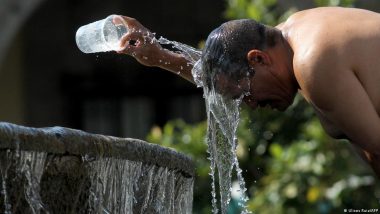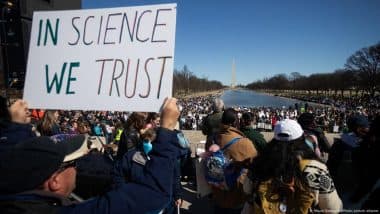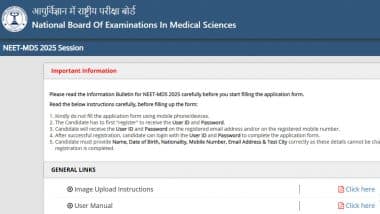It's hot, the sun is burning — and the risk of suffering heat exhaustion or heatstroke is rising. If one of them hits, quick action is needed. Even better: avoiding them in the first place.Sunshine at last! Time to go out to the park or the lake. Running, swimming, sunbathing — the main thing is to make the most of the nice weather.
Also Read | Health Tips: How to Stay Safe in a Heat Wave.
But at some point, enough is enough and our bodies need a break. If you spend too much time in the sun, you can get heat exhaustion. And those who work hard in the heat can even suffer a heatstroke. How it happens and how you can recognize both — here are some tips for a safe summer.
Also Read | Electric Jet in US: NASA Builds All-Electric Aircraft To Create Path Toward Electric Aviation.
What is heat exhaustion?
A lot of sun or the extreme temperatures of heat waves can make your body overheat and lead to heat exhaustion.
Heat exhaustion is a type of heat-related illness, like heat rash, heat cramps or heatstroke. Although it is less severe than heatstroke, if not properly handled it can lead to the more serious ailment.
A headache is usually the first sign of heat exhaustion. You are hot, your face is red, you sweat a lot, you move more slowly, and you're likely to experience fatigue, nausea and vomiting. You might also feel dizzy or even faint.
What you might not expect: The skin of someone with heat exhaustion is usually not hot, but rather cool.
Heat exhaustion: What to do?
First of all, those who are suffering from heat exhaustion should immediately be taken out of the sun, to a cool place or into the shade, and drink water as quickly as possible. Cold, damp cloths can help cool the body. In addition, someone with heat exhaustion should drink plenty of fluids to bring the water balance back to a normal level. Cold water or sports drinks replenish lost salts, but make sure to avoid alcohol and caffeine. They would dehydrate you even more, on top of excessive sweating, which can cause an additional fluid loss of up to two liters on very hot days, according to experts.
Until the symptoms get better, you need to rest.
Important: In severe cases, severe vomiting, confusion or even unconsciousness can occur. If that happens, you should definitely go see a doctor, if only to rule out heatstroke.
What is heatstroke?
The terms heat exhaustion and heatstroke are often confused. Rather than two distinct things, you can see them more as two different degrees of severity of your body getting hotter. But, heatstroke is more dangerous than heat exhaustion. Heatstroke can happen, for example, when you engage in physical activities in a hot environment or when heat exhaustion is not properly treated.
When it's extremely hot outside, the body absorbs more heat than it can release. The body temperature can rise to 41 °C (105.8 °F) within 10 to 15 minutes. This acute overheating leads to an inflammatory response throughout the body.
The body's temperature regulation system fails and sweat production, for example, stops. Sweating is how your body helps cool itself, so without it your body temperature starts rising.
Heatstroke is life-threatening. Symptoms include impaired consciousness, headache, dizziness and drowsiness; seizures, vomiting, diarrhea and low blood pressure may also occur. Heatstroke develops within one to six hours and can cause death in less than 24 hours unless properly treated.
In the elderly, chronically ill, and children, heatstroke usually occurs because of a combination of high temperatures and severe fluid and electrolyte deficiencies. In healthy adults, too much physical activity in hot sunny weather, such as sports or working outdoors, usually causes heatstroke.
Heatstroke: What to do?
At the first signs of heatstroke, emergency services must be alerted immediately. The affected person has to be taken out of the sun and heat, and to a cool place or into the shade. Their body should be cooled down as quickly as possible with cold water, ice baths or soaked clothes, and the affected person should be given fluids if possible. Excess clothing should be removed.
If unconscious but breathing normally, the person should be placed in a stable lateral position until emergency personnel arrive. Regular breathing and consciousness must be checked regularly. If the person is not breathing normally, resuscitation efforts must be started.
Avoiding heat exhaustion and heatstroke
In extremely high temperatures, our body's heat regulation system quickly reaches its limits. In addition, older people often drink too little water. As a result, the body cannot produce enough sweat, which in turn makes it difficult for the body to cool down on its own.
In many cases, it is then recommended and safest to call a doctor.
The best way to avoid heat exhaustion or even heatstroke is obvious: Don't get too much sun and especially avoid it around midday, protect your head with a light-colored hat, avoid exposure to extreme heat if possible, and drink plenty of fluids. As a rule of thumb, an adult needs at least half a liter of water extra on hot days.
This article was originally published in German
(The above story first appeared on LatestLY on Jun 27, 2023 07:30 PM IST. For more news and updates on politics, world, sports, entertainment and lifestyle, log on to our website latestly.com).







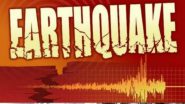
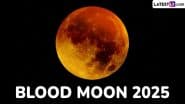

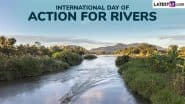


 Quickly
Quickly








